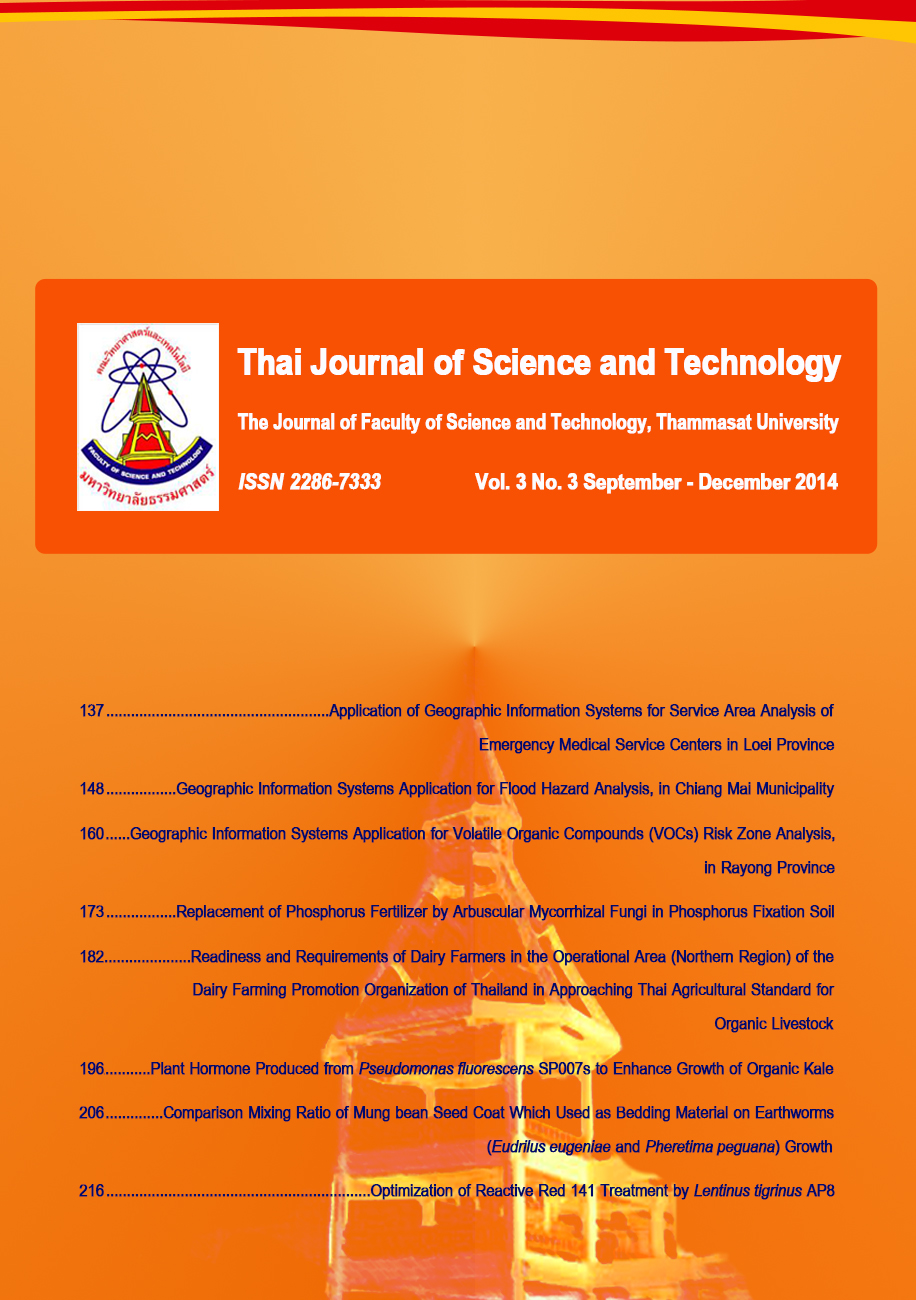การประยุกต์ระบบสารสนเทศภูมิศาสตร์เพื่อการวิเคราะห์พื้นที่เสี่ยงภัยสารอินทรีย์ระเหยง่าย จังหวัดระยอง
Main Article Content
Abstract
บทคัดย่อ
การประยุกต์ระบบสารสนเทศภูมิศาสตร์เพื่อการวิเคราะห์พื้นที่เสี่ยงภัยสารอินทรีย์ระเหยง่าย จังหวัดระยอง มีวัตถุประสงค์เพื่อศึกษาพื้นที่เสี่ยงภัยและผลกระทบจากการแพร่กระจายของสารอินทรีย์ระเหยง่าย ในบรรยากาศโดยทั่วไปค่าเฉลี่ยรายปีที่มีค่าความเข้มข้นเกินค่ามาตรฐานที่กำหนดตามประกาศกรมควบคุมมลพิษ โดยใช้ระบบสารสนเทศภูมิศาสตร์ประมาณค่าเชิงพื้นที่ด้วยวิธี inverse distance weighted (IDW) พบว่าในพื้นที่จังหวัดระยองมีการแพร่กระจายของสารอินทรีย์ระเหยง่ายในบรรยากาศทั่วไปค่าเฉลี่ยรายปีที่มีค่าความเข้มข้นเกินค่ามาตรฐานค่าเฉลี่ย 12 เดือน (moving average) ในปี พ.ศ. 2556 จำนวน 5 ชนิด คือ benzene, vinyl chloride, 1,2-dichloroethane, chloroform และ 1,3-butadiene ณ บริเวณจุดตรวจวัดคุณภาพอากาศ โรงพยาบาลส่งเสริมสุขภาพตำบลมาบตาพุด โรงเรียนวัดหนองแฟบ สถานีเมืองใหม่มาบตาพุด ชุมชนบ้านพลง ศูนย์บริการสาธารณสุขบ้านตากวน หมู่บ้านนพเกตุ โรงพยาบาลส่งเสริมสุขภาพตำบลบ้านหนองจอก และบริเวณวัดปลวกเกตุ ได้มีการจัดระดับพื้นที่ที่มีความเสี่ยงภัยเป็น 5 ระดับ คือ เสี่ยงมากที่สุด เสี่ยงมาก เสี่ยงปานกลาง เสี่ยงน้อย และเสี่ยงน้อยมาก จากการศึกษาพบว่าจำนวนหมู่บ้านที่ได้รับผลกระทบจากการแพร่กระจายของสารอินทรีย์ระเหยง่ายในบรรยากาศโดยทั่วไปในเวลา 1 ปี พบหมู่บ้านอยู่ในขอบเขตพื้นที่เสี่ยงภัยระดับเสี่ยงมากที่สุดจากสารอินทรีย์ระเหยง่ายที่เกินค่ามาตรฐานจำนวน 4 ชนิด 158 หมู่บ้าน คิดเป็นร้อยละ 38.92 ซึ่งเป็นอัตราความเสี่ยงที่สูงและเป็นปัญหาที่สำคัญของหน่วยงานในท้องถิ่นที่ควรให้ความสำคัญและเฝ้าระวังภัยจากสารอินทรีย์ระเหยง่ายในเขตพื้นที่จังหวัดระยอง
คำสำคัญ : ระบบสารสนเทศภูมิศาสตร์; สารอินทรีย์ระเหยง่าย
Abstract
The objective of this geographic information systems application for volatile organic compounds (VOCs) risk zone analysis in Rayong province is to study the risk areas and the impacts of the spread of volatile organic compounds in general atmosphere by using the annual average of 12-month statistics with concentration exceeding the standard values set by the Pollution Control Department. In processing with geographic information system estimating VOCs in form of a map showing the distribution by using Inverse distance weighted (IDW), it was found that, in Rayong province, there was the spread of five types of the VOCs i.e. benzene, vinyl chloride, 1,2-dichloro-ethane, chloroform and 1,3-butadiene, with 12-month moving average of concentrations exceeding the standard in general atmosphere. Monitoring was performed at the air quality monitoring points at Map Ta Phut health promoting hospital, Wat Nong Fab school, new Map Ta Phut city station, Ban Phleng community, Ban Takuan health center, Nop Ket village, Ban Nong Chok health promoting hospital and Wat Pluak Ket vicinity. According to the VOCs risk areas assessment, the risks were classified into five levels, i.e. highest, high, moderate, low, and very low. 158 villages of 406, representing 38.92 percent, were found located in the highest risk zone of 4 types of VOCs exceeding the standard. The risk was classified high and this is a major local problem that needs to be cancerned and monitoring on VOCs danger in the area of Rayong province.
Keywords: geographic information systems (GIS); volatile organic compounds (VOCs)
Article Details
บทความที่ได้รับการตีพิมพ์เป็นลิขสิทธิ์ของคณะวิทยาศาสตร์และเทคโนโลยี มหาวิทยาลัยธรรมศาสตร์ ข้อความที่ปรากฏในแต่ละเรื่องของวารสารเล่มนี้เป็นเพียงความเห็นส่วนตัวของผู้เขียน ไม่มีความเกี่ยวข้องกับคณะวิทยาศาสตร์และเทคโนโลยี หรือคณาจารย์ท่านอื่นในมหาวิทยาลัยธรรมศาสตร์ ผู้เขียนต้องยืนยันว่าความรับผิดชอบต่อทุกข้อความที่นำเสนอไว้ในบทความของตน หากมีข้อผิดพลาดหรือความไม่ถูกต้องใด ๆ


